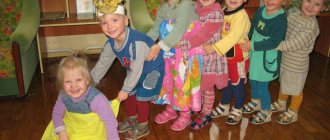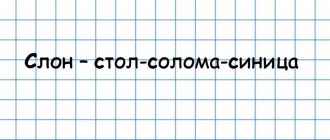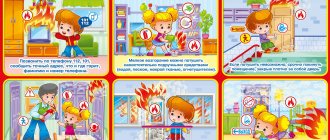It is no secret that fires most often occur due to the carelessness of people, and the most careless of us are children. This is why it is so important to introduce fire safety games for children from a very early age. Through play, kids learn to understand what objects can catch fire and what to do in a life-threatening situation.
At what age should fire safety rules be taught?
Dangers await people everywhere. At any moment an accident, fire, animal bite, etc. can happen. An adult has a certain model of behavior in this case, but a child does not. Therefore, it is so important to give him knowledge about possible threatening situations and objects. Children receive their first lessons in the family: “you can’t touch matches,” “it’s dangerous to approach the stove.” In the garden they deepen this knowledge.
It is recommended that children be introduced to fire safety rules from the age of 3 years. First, a series of introductory lessons are conducted to help you learn what is dangerous and what is not. Children learn to recognize fire hazards and handle them correctly. Later, starting from 4–5 years old, they learn to understand the interconnection of events: “a lit match can lead to a fire in the house, an unextinguished fire can burn a forest.”
Questions and answers on fire safety
Goal : to consolidate knowledge about the correct actions in the event of a fire.
Progress of the game:
Questions and answers are presented in the form of pictures (questions on one tray, answers on the other). For each situation it is necessary to choose the right answer.
Situations:
- There was a fire.
- There is a lot of smoke in the room.
- Your clothes are on fire.
- The TV started smoking.
- The old grass is burning.
- I smelled gas.
- It is difficult to breathe from the acrid smoke.
Answers:
- Call "01".
- Crawl your way to the exit.
- Get on the floor and roll.
- Turn it off, cover with a blanket.
- Cover it with soil and fill it with water.
- Open the window, call “04”.
- Breathe through the wet rag.
How to behave in case of fire?
At a young age, a child is not able to put out a fire and follow the rules that exist for adults.
Up to 6 years of age, children must know and follow only 3 points:
- Do not touch flammable objects.
- In case of fire, notify parents, neighbors, and teacher as soon as possible.
- Remain in the sight of adults, obey them in everything and try to behave calmly.
At 7–8 years old, when the child begins to be left unattended, he is told about the first fire safety rules:
- If the fire is small, try to extinguish it by throwing a thick cloth, pouring a pan of water or covering it with sand.
- If this does not help or the fire is large, immediately leave the dangerous place.
- Don't hide under the bed or in the closet, but if possible, get out of the house.
- If you are locked inside, close the windows and doors in the room where the fire occurred. Take your phone and lock yourself in the bathroom. Plug all the cracks and the hood.
- Call the fire department on 101 as soon as possible or ask adults to do this: neighbors, passers-by.
- Smoke is more dangerous than fire. If you feel like you're starting to choke, lie down on the floor. There is always less smoke at the bottom.
- Do not use the elevator during a fire - it may shut down. Just go down the stairs.
- Stay calm and don't try to leave the house through the window.
- When the firefighters arrive, obey them in everything and do not be afraid. They will help you.
Progress of the game:
The child is offered a set of subject pictures (fire extinguisher, bucket of water, TV, telephone, sandbox, electrical socket, fire hose, kerosene fireman's helmet , lighter, gas stove, gas mask) from which he must select those used in extinguishing fires and those that are the cause fire occurrence . The one who answers correctly gets a chip. The player with the most chips wins
5. Didactic game: “Fold the picture ”
Goal: to consolidate knowledge about the rules of behavior during a fire . Develop imagination, logical thinking, fine motor skills. Cultivate perseverance.
How to properly tell your child about fire safety rules?
You can tell your child as much as you like about safe behavior, but he is unlikely to remember and learn the instructions well. The main activity of children is play. It is easier to convey any information to children through play. In the game process, the child sees a clear example, acts out actions, and better understands cause-and-effect relationships.
There are several types of fire safety games for children:
- Didactic. They include games with objects and cards, board games and word games with riddles. For example, you need to cover a card with fire with a picture of water or continue the phrase: “I saw smoke - don’t yawn and call the firefighters... (call). “Don’t touch the stove with your hand if there’s a fire in it... (fire).”
- Movable. They help develop attentiveness, dexterity, and form a model of behavior in a life-threatening situation.
- Role-playing. Children take on the roles of firefighters, parents, children and solve the task.
It is recommended to support the oral material presented with a clear example. It is best to prepare a presentation with picture slides for the lesson. Instead of a dry presentation, you can use poetry:
“Mom-mouse ironed a suit for her daughter in the dark night. She got distracted and suddenly Forgot about the iron. This is no joke, it broke out in three minutes. Everything is in smoke, there is fumes all around, That’s how a fire happens!”
“Children were playing by the fire, Petya’s jacket caught fire, he rushed about in fright, But Nikita helped his friend: he knocked Petya onto his side and doused him with water... They had to throw earth on him so that the flames would subside. It is forbidden to run in burning clothes; the wind makes the fire flare up stronger!”
To consolidate the material, it is useful to make crafts and applications. In the kindergarten, teachers instruct parents to draw warning posters together with their children. You can make crafts from plasticine, colored cardboard and other materials. Example:
Progress of the game:
The child is shown a picture depicting various uses of fire (both good and bad)
.Children are given
cards with images of fire and objects related to fire (matches, firewood, gas stove, kerosene lamp, etc.)
Children must place
the cards on the picture - in the right place .
7. Didactic game: “Say a word”
Goal: to consolidate knowledge about fire . Develop vocabulary, attention, memory.
Examples of role-playing games
Role-playing games are carried out in the middle and senior groups of kindergarten. Recommended age: 4–5 and 6–7 years.
- “Everyone is leaving.” Players line up along the wall. At the opposite end of the room there are chairs with equipment: a helmet, gloves, a belt, a hose, a toy ladder and a fire extinguisher. When the whistle blows, the children run to the chairs and put on their equipment. Whoever does it faster wins.
- "Teamwork". Children are divided into 2 groups and lined up. A basin with water and a ladle is placed at the beginning of the line, and an empty basin is placed at the end. You need to scoop up the water and pass it to the player standing next to you. Children pass a ladle of water along a chain and pour it into an empty basin. The last player runs with an empty scoop to the beginning of the line, draws water and passes it to the team. The game continues until the first bowl is empty. The winner is the team that transfers all the water before the other. The amount of water transferred is also taken into account (whether it was spilled too much).
- “Is fire good or evil?” Each child is given a card. All cards have different pictures: cooking dinner over a fire, lighting a house, fireworks, a rocket flying. And also a fire in the forest, a burning house, a person coughing from the smoke, frightened children. In front of the children there is a stand with 2 drawn lights - good and evil. The child needs to approach the fire in accordance with his card and explain in his own words why the fire is good or evil. At the end of the game, the adult sums it up: “Fire is both good and evil. It all depends on how you handle it.”
- "Brave firefighters." Children are divided into boy-girl pairs. The girls sit on a chair and play the role of fire victims. The boys are rescue firefighters who must overcome an obstacle course and lead the girl by the hand to a safe place. The couple that runs back first wins.
- "Extinguishing the fire." The game involves 2 players. In front of each person, 6 red scraps (lights) and 10 pictures with objects that can be used to put out the fire are scattered on the floor. Among them are 4 incorrect ones: paper, firewood, doll, inflatable ball. When the whistle blows, you need to cover the “lights” with the correct pictures. Whoever completes the task first wins.
For role-playing games on the topic of fire safety, it will be useful to equip a corner with household items: an iron, stove, matches, as well as toys, an album and everything that is at home. Children act out a given scenario: “The parents left, and you were left alone at home. What will you play with? Or: “You are playing in the room and suddenly you smell smoke. What will you do?". You can distribute roles among children and divide them into parents, firefighters, children, neighbors, etc.
Children aged 3–6 years copy the actions of adults in their games. And all “adult” activities and subjects arouse strong interest. Do not tempt fate and keep matches, flammable liquids, candles, electric stoves and other fire hazards in a visible place. Do not use them in games and regularly have preventive conversations with your child. It is recommended to conduct a full-fledged fire safety lesson 1-2 times a year, starting from 3 years of age. In kindergarten, firefighters are invited, they show presentations and play games. Then life safety lessons are held at school. Children are given in-depth knowledge and taught how to properly handle fire-hazardous objects, and not avoid them.
Progress of the game:
From the plot pictures (children collecting autumn leaves, children hanging burning candles on a Christmas tree, a boy playing with matches in the closet, children watering flowers, etc.), the child must choose those situations that could cause a fire and justify his answer, for that gets the chip. The one who has the most chips at the end of the game wins.
4. Didactic game: “Choose the right one”
Goal: to develop children’s knowledge about the items needed when extinguishing a fire , the rules for their use . Reinforce knowledge about objects that can cause a fire . Develop speech, memory, logical thinking. Foster a sense of responsibility
Progress of the game:
From the four proposed pictures depicted on one card, the child chooses the extra one related or not related to the fire . Example – boiler, comb, saucepan, box; carpet, TV, painting , chair, etc.
Role-playing games:
"We are firefighters "
Preliminary work:
excursion to the fire station ,
conversations about the work of firefighters ,
looking at story pictures ,
reading stories about fire (L. Tolstoy “ fire dogs” , S. Marshak “Cat’s House”
, S. Mikhalkova
"
fire " ,
drawing on this topic,
playing out situations about the rules of behavior in a fire ,
educational games,
OOD on this topic.
Goal: to develop the ability to develop a plot based on knowledge of PPD; coordinate your actions with the actions of your partners, observe role interactions and relationships in the game. Coordinate and predict role-playing actions and behavior in accordance with the plot of the game.
Equipment: set of fire trucks , helmets for firefighters , buckets, shovels, substitute items - cords, jump ropes, Swedish ladder, sports rope, sports mats, set of toys “We are firefighters ”
, tape recorder (audio recording
“
fire flasher ” ).
9. Game with the floor constructor “ Fire in the city ”
.
Preliminary work:
Construction of buildings,
Games with floor constructor,
Examination of the city street plan,
Tour of the nearby neighborhood,
Playing out situations on the theme “ a fire truck on the city streets”
,
Conversations about the firefighter ,
Guessing riddles
10. Games with transport toys
Conversations about traffic rules
Goal: to consolidate the ability to take on various roles in accordance with the plot of the game; use attributes, constructor, building material, substitute objects. Promote the creative use of ideas about PPD in the game. Develop creative imagination, the ability to jointly unfold the yoke.
Equipment: different types of floor construction sets, diagram cards , toy fire trucks , small toys, audio recording of a fire flasher .
11. "Young firefighters rush to the rescue "
Lesson-travel on fire safety for children of the preparatory group
Program content:
- teach children to navigate problem situations;
— introduce children to fire and its properties;
— expand children’s vocabulary on the topic of fire safety ;
— consolidate children’s knowledge about dangerous situations, causes of fire and rules of conduct in case of fire ;
— to instill in children the need to take care of their safety ;
- develop curiosity, memory, logical thinking.
Equipment: Bus-tent, headphones, computers, drum for the game “Field of Miracles”
,
pictures for playing “Field of Miracles”
, interactive whiteboard, markers,
firefighter , firefighter costumes for children (helmets, vests)
.
For the game “Put out
the fire ” : a model of a fire, buckets of sand, water, earth, snow, a shovel, a fire extinguisher, dry branches, paper, plastic objects, polystyrene foam, plastic bottles,
pictures with illustrations of fire safety rules . Material for experiments with fire: metal tray, paraffin candles, containers with water, sand, earth, snow, glass flask. Music center, audio recording “The Tale of a Naughty Match”
, audio recording of the melody of the song
“We are going, going, going...”
music by M. Starokadomsky, poetry by teacher E. A. Pishchik






